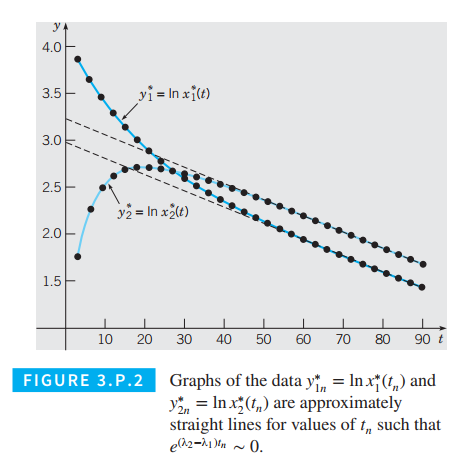
Estimating Eigenvalues and Eigenvectors of
respectively. The solution of Eq. (1) can be expressed as
where
(a) For values of
(b) Given that both components of the data

Want to see the full answer?
Check out a sample textbook solution
Chapter 3 Solutions
DIFFERENTIAL EQUATIONS(LL) W/WILEYPLUS
Additional Math Textbook Solutions
Introductory Statistics
Intro Stats, Books a la Carte Edition (5th Edition)
Thinking Mathematically (6th Edition)
A Problem Solving Approach To Mathematics For Elementary School Teachers (13th Edition)
Calculus: Early Transcendentals (2nd Edition)
Elementary Statistics: Picturing the World (7th Edition)
- Can you help me understand this analysis? A 95.7% confidence interval is shown for the intention-to-treat analysis (accounting for alpha spending in interim analyses), and 95% confidence intervals are shown for the other two analyses. The widths of the confidence intervals have not been adjusted for multiplicity. The dashed line indicates the noninferiority margin of 4 percentage points.arrow_forward1 Solve for (x, y, z) in the set of linear, inhomogeneous equations: x-y+2x=5 2x + 3y - z = 4 2x-2y+4z6.arrow_forwardThe sides of a triangular prism base measures 6cm, 8cm and 10cm while it's height is 12cm. Determine the total surface area of the prism in square cmarrow_forward
- No chatgpt pls will upvotearrow_forwardA carpenter charges a fixed fee for labour and an additional fee per hour for materials. The total cost for a 4 hour job is sh 1200 and the total cost for an 8 hour job is sh 2200. Determine the fixed labour fee and the hourly rate for materialsarrow_forwardQuestion 7: Find a matrix Ps which can be used as a premultiplier an arbitrary 5 x n matrix A to effect the following changes in A: Row 1 becomes Row 3 + 2 Row 5 Row 2 becomes Row 5+ Row I Row 3 becomes 2 Row 2 + 3 Row 4 Row 4 becomes Row 1 + Row 5 Row 5 becomes Row 2 + Row 3 + Row 4arrow_forward
- "P3 Question 3: Construct the accessibility matrix Passociated with the following graphs, and compute P2 and identify each at the various two-step paths in the graph Ps P₁ P₂arrow_forwardA cable television company estimates that with x thousand subscribers, its monthly revenue and cost (in thousands of dollars) are given by the following equations. R(x) = 45x - 0.24x2 C(x) = 257 + 13xarrow_forwardCompare the interest earned from #1 (where simple interest was used) to #5 (where compound interest was used). The principal, annual interest rate, and time were all the same; the only difference was that for #5, interest was compounded quarterly. Does the difference in interest earned make sense? Select one of the following statements. a. No, because more money should have been earned through simple interest than compound interest. b. Yes, because more money was earned through simple interest. For simple interest you earn interest on interest, not just on the amount of principal. c. No, because more money was earned through simple interest. For simple interest you earn interest on interest, not just on the amount of principal. d. Yes, because more money was earned when compounded quarterly. For compound interest you earn interest on interest, not just on the amount of principal.arrow_forward
- Reduce the matrix to reduced row-echelon form. [3 2 -2-191 A = 3 -2 0 5 + 2 1 -2 -14 17 1 0 0 3 0 1 0 0 0 4arrow_forwardCompare and contrast the simple and compound interest formulas. Which one of the following statements is correct? a. Simple interest and compound interest formulas both yield principal plus interest, so you must subtract the principal to get the amount of interest. b. Simple interest formula yields principal plus interest, so you must subtract the principal to get the amount of interest; Compound interest formula yields only interest, which you must add to the principal to get the final amount. c. Simple interest formula yields only interest, which you must add to the principal to get the final amount; Compound interest formula yields principal plus interest, so you must subtract the principal to get the amount of interest. d. Simple interest and compound interest formulas both yield only interest, which you must add to the principal to get the final amount.arrow_forwardSara would like to go on a vacation in 5 years and she expects her total costs to be $3000. If she invests $2500 into a savings account for those 5 years at 8% interest, compounding semi-annually, how much money will she have? Round your answer to the nearest cent. Show you work. Will she be able to go on vacation? Why or why not?arrow_forward
 Linear Algebra: A Modern IntroductionAlgebraISBN:9781285463247Author:David PoolePublisher:Cengage LearningAlgebra & Trigonometry with Analytic GeometryAlgebraISBN:9781133382119Author:SwokowskiPublisher:Cengage
Linear Algebra: A Modern IntroductionAlgebraISBN:9781285463247Author:David PoolePublisher:Cengage LearningAlgebra & Trigonometry with Analytic GeometryAlgebraISBN:9781133382119Author:SwokowskiPublisher:Cengage Elementary Linear Algebra (MindTap Course List)AlgebraISBN:9781305658004Author:Ron LarsonPublisher:Cengage Learning
Elementary Linear Algebra (MindTap Course List)AlgebraISBN:9781305658004Author:Ron LarsonPublisher:Cengage Learning


